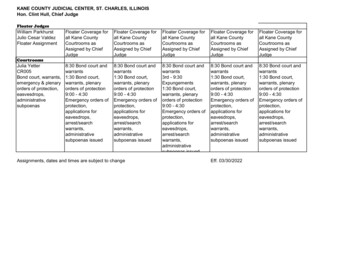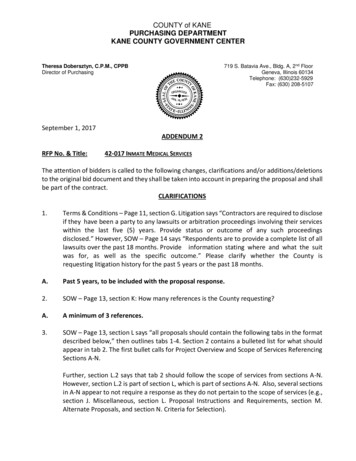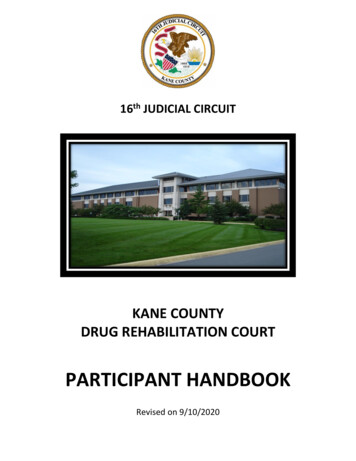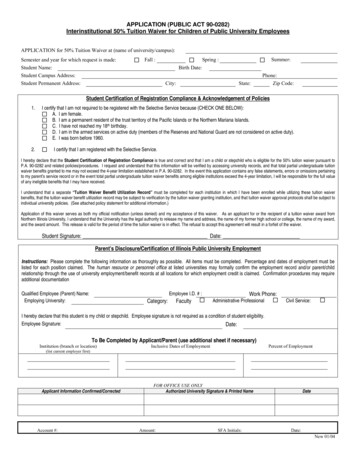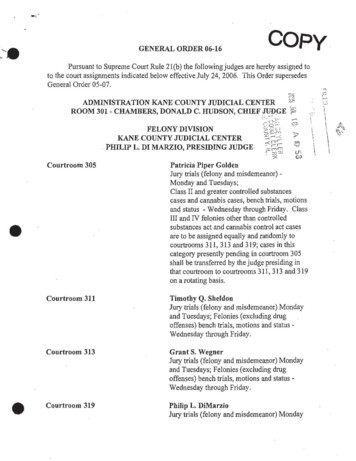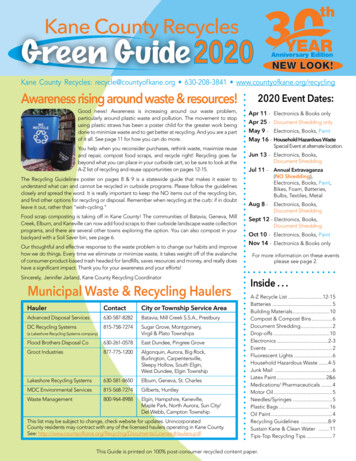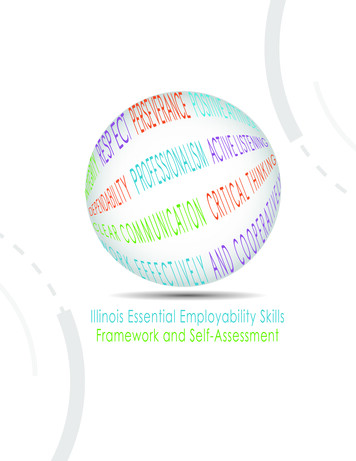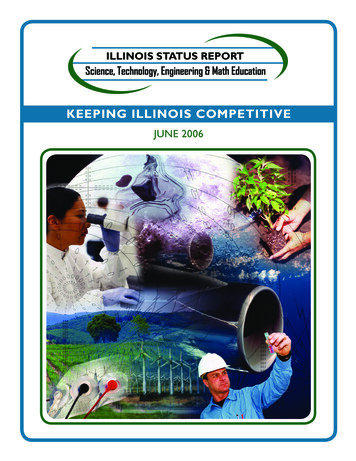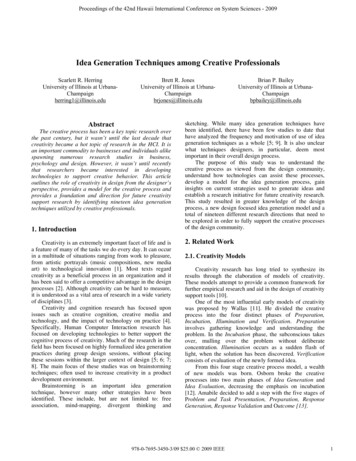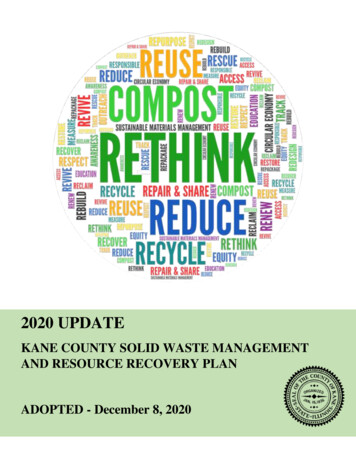
Transcription
2020 UPDATEKANE COUNTY SOLID WASTE MANAGEMENTAND RESOURCE RECOVERY PLANADOPTED - December 8, 2020
Prepared by theKane County Division of Environmental and Water Resources(Geneva, Illinois) andAptim Environmental & Infrastructure, LLCKane County Solid Waste Management and Resource Recovery Plan2020 UpdatePage i
KANE COUNTY BOARD MEMBERSChristopher J. Lauzen*, Chairperson / Corrine Pierog , ChairpersonMyrna MolinaDistrict 1, AuroraSteve WeberDistrict 13, St. CharlesTheresa Barreiro* / Dale Berman District 2, Aurora / North AuroraMark DavoustDistrict 14, St. CharlesAnita LewisDistrict 3, AuroraBarbara WojnickiDistrict 15, Campton HillsAngela C. Thomas* / Mavis Bates District 4, AuroraMichael KenyonDistrict 16, South ElginBill LenertDistrict 5, Sugar GroveDeborah AllanDistrict 17, ElginMatt Hanson* / Ron Ford District 6, AuroraDrew FraszDistrict 18, ElburnMonica SilvaDistrict 7, AuroraMohammad "Mo" IqbalDistrict 19, ElginBarbara Hernandez* / Michelle Gumz District 8, AuroraPenny Wegman* / Cherryl Fritz Strathmann District 20, ElginThomas A. KoppieDistrict 9, HuntleyClifford SurgesDistrict 21, GilbertsSusan Starrett* / David Brown District 10, BataviaDouglas Scheflow* / Verner Tepe District 22, ElginJohn MartinDistrict 11, GenevaChris KiousDistrict 23, AlgonquinJohn J. Hoscheit* / Kenneth Shepro District 12, St. Charles / WayneJarett SanchezDistrict 24, Carpentersville* denotes Kane County Board Member during development of 2020 Update, no longer in office attime of 2020 Update adoption. denotes new Kane County Board Member elected in November 4, 2020 general election.Kane County Solid Waste Management and Resource Recovery Plan2020 UpdatePage ii
Kane County BoardEnergy and Environmental Committee2020Barbara Wojnicki, ChairSteve Weber, Vice ChairDeborah AllanTheresa BarreiroChris KiousBarbara HernandezJarett SanchezKane CountyDivision of Environmental & Water ResourcesJodie Wollnik; Division DirectorJennifer Jarland; Recycling CoordinatorKane County Solid Waste Management and Resource Recovery Plan2020 UpdatePage iii
TABLE OF CONTENTSEXECUTIVE SUMMARY . 1SECTION 11.11.21.31.4INTRODUCTION AND BACKGROUND . 5Planning Background and Purpose of Update . 5Plan Development Process . 5Terminology and Scope . 6Factors Impacting Materials Management Planning . 9SECTION 2 PLAN UPDATES AND IMPLEMENTATION . 112.1History of Plan Updates . 112.1.1 1992 Kane County Solid Waste Management Plan . 112.1.2 1997 Plan Update . 112.1.3 2004 Plan Update . 122.1.4 2009 Plan Update . 122.1.5 2015 Plan Update . 122.2Implementation Status of the 2015 Plan Update. 13SECTION 3 SOLID WASTE GENERATION, COMPOSITION, INFRASTRUCTURE,AND CAPACITY . 203.1Demographic Trends . 203.2Waste Generation . 213.2.1 Generation . 213.2.2 Composition . 263.3Disposal Capacity . 273.4Waste and Diversion Infrastructure . 303.4.1 Siting Approval for Future Infrastructure Development . 313.4.2 Host Community Benefit Agreements . 32SECTION 44.14.24.34.4MATERIALS MANAGEMENT . 33Sustainable Materials Management and Circular Economy . 33Waste Minimization . 34Traditional Material Recycling & Diversion . 354.3.1 Ordinance . 354.3.2 Collection and Processing . 364.3.3 Residential Recycling . 374.3.4 Commercial Recycling. 394.3.5 Organics . 414.3.6 Construction & Demolition Sector . 42Non-Traditional Materials Management. 44Kane County Solid Waste Management and Resource Recovery Plan2020 UpdatePage iv
4.54.64.4.1 Batteries . 454.4.2 Bikes . 464.4.3 Books . 474.4.4 Carpet and Padding . 484.4.5 Confidential Documents . 484.4.6 Electronic Equipment. 494.4.7 Fluorescent Bulbs. 514.4.8 Household Hazardous Waste . 514.4.9 Latex Paint . 544.4.10 Motor Oil . 554.4.11 Pharmaceuticals . 554.4.12 Textiles. 554.4.13 Tires . 564.4.14 Other Materials . 574.4.15 Facilities for Non-Traditional Materials Management . 57Disposal. 58Alternative Technologies . 59SECTION 55.15.25.3PUBLIC EDUCATION AND INFORMATION. 60Public Education Portfolio . 60Alignment of Messaging . 61School Programs . 61SECTION 66.16.26.36.4ECONOMICS AND FUNDING . 62Conditions Affecting Waste Quantities . 62Waste and Recycling-Based Economic Activity . 62Funding Sources. 64Partnerships and Intergovernmental Assistance . 64SECTION ENDATIONS. 66Waste Minimization (Section 4.2) . 66Residential Recycling (Section 4.3.3) . 66Commercial Recycling (Section 4.3.4) . 66Organics (Section 4.3.5) . 67Construction and Demolition (Section 4.3.6) . 67Electronics (Section 4.4.6) . 67Household Hazardous Waste (Section 4.4.8) . 67Textiles (Section 4.4.12) . 68Other Non-Traditional (Hard-to-Recycle) Materials (Sections 4.4.14 & 4.4.15) . 68Disposal (Section 4.5) . 68Alternative Technologies (Section 4.6) . 68Public Information and Education (Section 5). 68Economics and Funding (Section 6.3) . 69Kane County Solid Waste Management and Resource Recovery Plan2020 UpdatePage v
7.147.15FIGURESFigure ES.1Figure ES.2Figure 1.1Figure 3.1Figure 3.2Figure 3.3Figure 3.4Figure 3.5Figure 3.6Figure 4.1Figure 4.2Figure 4.3Figure 4.4Figure 4.5Figure 4.6Figure 4.7Figure 4.8Figure 4.9Figure 4.10Figure 4.11Figure 4.12TABLESTable 2.1Table 3.1Table 3.2Table 3.3Table 3.4Table 3.5Table 3.6Table 4.1Table 7.1Partnerships and Intergovernmental Assistance (Section 6.4) . 69Implementation Schedule for Deliverable Recommendations . 69Kane County’s Role in Municipal Waste Management .2Summary of Deliverable Recommendations for the 2020 Plan Update .4Map of Kane County.8Kane County Demographic Trends (1980-2050) .20Waste Generation and Management from Licensed Hauler Reports,by Sector (2015-2019) .22Landfilled Urban Residential Waste Composition .26Landfilled Urban Commercial Waste Composition .27Illinois EPA Regions.28Regional Infrastructure Utilized by Kane County .31Material Flow in a Circular Economy .33Non-Traditional Materials Diversion (2015-2019) .45Battery Recycling (2015-2019).46Bike Recycling (2015-2019) .47Book Recycling (2015-2019).48Document Shredding (2015-2019) .49Electronics Recycling (2015-2019) .50Fluorescent Bulb Recycling (2015-2019) .51HHW Collection Through Permanent Facility andHome Collection Service (2015-2019) .52Latex Paint Recycling (2015-2019) .54Textiles Recycling (2015-2019) .56Example Facilities for Non-Traditional Material Diversion .58Implementation Status of 2015 Recommendations .13Long-Term Demographic Projections (2010-2050) .21Per Capita Generation and Material Management by Sector (2019) .24Kane County Generation and Material Management by Sector (2019 and 2050) . 25Municipal Solid Waste Generation Estimates (1989-2050) .25Landfill Disposal Volume and Life by Region (as of January 1, 2019) .28Landfill Capacity and Disposal Volume at Facilities used by Kane CountyWaste Haulers (as of January 1, 2019) .29Municipal Franchise Haulers (as of July 2020) .37Proposed Implementation Schedule for Deliverable Recommendations .70APPENDICESAppendix A Regulatory Component: Local Ordinances and State LegislationAppendix B Sample Host Community Benefit AgreementKane County Solid Waste Management and Resource Recovery Plan2020 UpdatePage vi
EXECUTIVE SUMMARYThe Illinois Solid Waste Planning and Recycling Act was adopted in 1988 and requires all Illinoiscounties to plan for the management of solid waste generated within their borders. Solid wastemanagement plans are also required to be updated every 5 years to reflect current waste generationand waste management practices, review implementation status of plan recommendations, andidentify modified or new recommendations based on current conditions.Kane County adopted its first Solid Waste Management Plan in 1992. Plan Updates have sincebeen adopted in 1997, 2004, 2009, and 2015. This 2020 Plan Update supersedes all previous PlanUpdates and reflects the current recommendations and policies of Kane County related tomunicipal waste management.Kane County seeks to foster a strong policy and plan for sustainable materials management withinthe County and the surrounding region through the current Plan Update. A number of factors haveimpacted, and continue to impact, waste generation and management trends and practices in KaneCounty and the region, as well as nationally. Emerging concepts such as the Circular Economy,and an eye to material management beyond the traditional waste management view, will continueto shape the landscape of solid waste management for the coming 5 years and beyond, and thecurrent Plan Update takes these into consideration.The 2020 Plan Update follows a similar format to the 2015 Plan Update and includes the followingelements: Identification of notable impacts on solid waste planning over the past 5-year planningperiod;A summary of the implementation status of recommendations from the 2015 Plan Update;Updated waste generation, diversion, and waste flows information;A summary of materials management practices, including services provided by privatewaste and recycling companies and by Kane County;Review of public education and information to advance diversion programs and increaseenvironmental awareness throughout the County;Discussion of economics and funding considerations;Identification of recommendations in every key focus area of the 2020 Plan Update; andAn implementation schedule for deliverable recommendations.Kane County’s Division of Environmental and Water Resources has the primary responsibility fordeveloping and implementing the County’s Plan Updates. Through the efforts of the County’sRecycling Coordinator, the County engages in a number of activities related to solid wastemanagement, as outlined in Figure ES.1.Kane County Solid Waste Management and Resource Recovery Plan2020 UpdatePage 1
Figure ES.1 - Kane County’s Role in Municipal Waste ManagementKane County Does: Update and drive initiatives within the Kane County Solid Waste Plan. Require, by ordinance, all residential, commercial, and institutionalproperties to recycle, and to contract for separate recycling service, andrequire haulers to provide recycling service to all accounts for which theyprovide trash service. License waste and recycling haulers that operate in Kane County. Collect data from licensed haulers regarding waste, recycling, and organicscollection quantities and accounts served. Plan, promote, and operate (with County staff and contractors) recyclingprograms for non-traditional recyclable materials, including permanentcollection facilities and one-day events. Participate in local, regional, and state-level organizations and stakeholdergroups to advance waste reduction and diversion. Promote waste reduction, increase diversion, and ensure continued publicawareness of waste management and recycling opportunities available to theCounty. Manage the curbside hauler contract for Mill Creek Special Service Area, inorder to secure the lowest price and best service for the residents in thisunincorporated County community.Kane County Does Not: Collect waste, recyclables, or organics from residential, commercial, orinstitutional properties. Manage franchised hauler contracts for cities or townships, which aregenerally managed by municipal public works departments and townshipsolid waste disposal districts, or supervisors on behalf of the residents. Own or operate any active waste transfer or disposal facilities.Kane County continues to grow rapidly, and with this population growth comes projected increasesin materials to be managed. The County’s population has grown nearly 70% over the past 30 years,Kane County Solid Waste Management and Resource Recovery Plan2020 UpdatePage 2
from 317,471 in 1990 to 532,403 in 20191. Population is projected to grow nearly 50% more by2050, to a projected 780,678 people2. The impact of this population growth will be significant onthe County’s resource management infrastructure because it will continue to increase the demandfor managing solid waste, recyclables, and compostable organic materials generated within theCounty.Based on the current population and a calculated waste generation rate of 8.21 pounds per capitaper day, the County generated approximately 798,000 tons of materials to be managed in 2019. Ofthis, approximately 37% was diverted through recycling and composting, and the remaining503,000 tons of waste was disposed. There are no landfills operating in Kane County; as a result,all waste is transported out of the County for disposal. Two privately-owned transfer stations arecurrently operating in the County, providing increased efficiency to transport waste to regionallandfills outside of Kane County. The County also relies on a number of waste and diversionfacilities outside its borders to manage materials.While Kane County does not provide broad-based collectionor disposal services, the County has historically provided anumber of diversion opportunities through special collectionevents and permanent recycling centers to supplementservices provided by the private sector. These programstypically serve “non-traditional” recyclable materials such aselectronics, household hazardous waste, and various hard-torecycle materials that are not collected in curbside programs.Over the past 5 years, County programs have diverted morethan 7.7 million pounds of materials from disposal.Kane County DiversionProgram SuccessOver the past 5 years,Kane County’s specialcollection events andrecycling centers havediverted more than 7.7million pounds ofmaterials from disposal.For the coming 5-year planning period, the 2020 Plan Updatehas identified 26 recommendations in 14 different areas of focus. A number of theserecommendations are ongoing recommendations geared towards sustaining current activities ofthe County in solid waste management. However, 9 of the recommendations are new andhighlighted as “deliverable” recommendations for the planning period. These recommendationswill receive particular implementation focus during the planning period to enhance and advancethe County’s solid waste management system.Deliverable recommendations for the 2020 Plan Update are identified in Figure ES.2, numberedbased on their position in the recommendations contained in Section 7 of this Plan Update.Deliverable recommendations are also highlighted as they are introduced or referenced in Section4 of the Plan Update.12U.S. Census, Annual Estimates of the Resident Population for Counties in Illinois: April 1, 2010 to July 1, s/demo/popest/2010s-counties-total.html, accessed May 27, 2020.Chicago Metropolitan Agency for Planning, On to 2050 Local Forecasts, October 2018.Kane County Solid Waste Management and Resource Recovery Plan2020 UpdatePage 3
Figure ES.2 - Summary of Deliverable Recommendations for the 2020 Plan Update7.1-A: Waste Minimization - Engage in discussions with other area counties and statewideorganizations regarding development of the Circular Economy regionally, and bring togetherstakeholders from the business community, local governments, and policy makers to dialog onthe Circular Economy.7.2-A: Residential Recycling - Conduct one-on-one outreach to municipalities with belowaverage residential diversion rates based on review of annual hauler reports to identify how theCounty can assist in promoting increased waste reduction and lower contamination ratesthrough education and outreach efforts.7.3-A: Commercial Recycling - Determine and implement a method of confirming commercialand multi-family dwelling tonnage data provided in the annual tonnage reports by haulers iscomprehensive, potentially by cross referencing with tonnage estimates from area transferstations obtained through future annual surveys of these facilities.7.4-C: Organics - Research the feasibility of incorporating food scrap collection at KaneCounty Recycling Center locations.7.6-B: Electronics - Pilot Saturday hours at permanent Recycling Centers as alternative toevents, and explore the feasibility of opening an additional permanent recycling location forelectronics in Kane County, to create increased convenience to residents in the southernportion of the County.7.8-A: Textiles - Incorporate additional textile drop-off locations around the County if 2020pilot appears successful; apply lessons learned during 2020 pilot and from other area counties.7.9-B: Non-Traditional (Hard-to-Recycle) Materials - Pilot collection of additional materialsat existing County Recycling Centers and explore the feasibility of developing a Kane CountyRecycling & Reuse Center to serve as a one-stop-drop for residents to deliver predominantlynon-traditional materials for reuse and recycling.7.12-C: Public Information and Education - Create series of online educational videostargeted at various sectors, on topics such as: repair & share solutions; recycling guidelinesand activities for students; recycling guidelines and tips for residents and for businesses; andhow to compost at home and at work.7.13-A: Economics and Funding - Establish additional funding sources to support delivery ofrecycling program services, including through the following methods:1. Pursue grant opportunities as available and appropriate to support implementation ofPlan recommendations (e.g., Closed Loop Fund, USEPA grants, The RecyclingPartnership, etc.).2. Explore feasibility of a local governmental partner contribution to County recyclingprograms that serve their residents. This funding source would be established using amechanism similar to the household hazardous waste clause in municipal waste haulercontracts which is applied to collection of household hazardous waste and othermaterials undesirable in curbside programs.Kane County Solid Waste Management and Resource Recovery Plan2020 UpdatePage 4
SECTION 1INTRODUCTION AND BACKGROUND1.1Planning Background and Purpose of UpdateWith the passage of the Illinois Solid Waste Planning and Recycling Act (SWPRA) (415 ILCS15/) in 1988, all Illinois counties were required to plan for the management of solid wastegenerated within their borders, and were required to update their plans every 5 years. Kane Countyadopted its first Solid Waste Management Plan in 1992, and has since adopted required updates in1997, 2004, 2009, and 2015. This 2020 Plan Update supersedes all previous Plan Updates andreflects the current recommendations and policies of Kane County related to municipal wastemanagement.The 2020 Plan Update serves to summarize existing materials management systems, infrastructure,and opportunities; related policies and programs; status of recommendations from the previousupdate; and to propose new recommendations that assist staff with strategic planning and guidedevelopment of future policies and programs.1.2Plan Development ProcessThe Kane County Recycling Program Coordinator, within the Division of Environmental andWater Resources, is responsible for implementing the recommendations in the Solid WasteManagement and Resource Recovery Plan and for producing five-year updates to the plan.This 2020 Update was developed in partnership with Aptim Environmental & Infrastructure, LLC(APTIM). This is the first time since the original 1992 Plan that a consultant was contracted toprovide professional expertise in resource management planning, with a focus on advising KaneCounty on how to foster a strong sustainable materials management movement within the Countyand surrounding region. The 2020 Update is a result of the collaborative effort of the Kane CountyRecycling Program Coordinator and APTIM, with the roles of each as follows: The Recycling Program Coordinator worked closely with APTIM, managing progressthrough bi-weekly check in meetings. The Recycling Coordinator drafted content for themain body of the plan, provided all data and other resources available on file in therecycling office to supplement those provided by the consultant, while managing allsupervision and guidance of the project to assure alignment with County intentions andcapabilities.APTIM contributed to the development of the Update by analyzing the effectiveness ofcurrent and proposed programs, updating waste generation and diversion rates anddeveloping future tonnage projections, offering counsel on national and regional bestpractices, providing sound data in support of recommendations, and contributing to thegraphic design, organization, and final presentation of the Update.Kane County Solid Waste Management and Resource Recovery Plan2020 UpdatePage 5
Data for this Update were sourced from internal County program reports and surveys, regionalreports, state reports, national census information, and reports compiled and supplied by APTIM.County staff, with support from APTIM, reviewed current research, analysis, and best practicesfrom regional, state, and national programs.The Director of the Division of Environmental and Water Resources along with the Energy andEnvironmental Committee reviewed this Plan Update and advised throughout the process. TheUpdate was reviewed publicly during a 45-day review period. The public review period runningfrom September 11, 2020 to October 26, 2020, was advertised through public notice, websiteposting, and email to all municipalities, townships, solid waste districts, waste haulers, andinterested parties.At the October 16, 2020 public meeting of the Energy and Environmental Committee, a call wasmade for comments to be made in person. Feedback received during the public review period hasbeen incorporated into this Plan Update.This Kane County Solid Waste Management and Resource Recovery Plan: 2020 Update waspassed by the Kane County Board on December 8, 2020.1.3Terminology and ScopeIt is worth noting that regional, national, and global trends towards rethinking the management ofour resources has led to greater use of terms such as “resource management,” “materials recovery,”“materials management,” or “sustainable materials management,” in addition to “solid wastemanagement” and “municipal waste management.” This plan may use these termsinterchangeably.With respect to quantities and material management methods described in the 2020 Plan Update,the following key terms are utilized:Generation: Refers to tonnages of all materials discarded, including through disposal ordiversion. Generation includes waste, recyclable materials, and organic materials managedthrough landfilling, recycling, and composting from the residential, commercial, andconstruction and demolition sectors (see subsequent definitions of these sectors below).Generation Rate: Calculation of the amount of generation on a unit basis; in this 2020 PlanUpdate, the generation rate is expressed on a pounds per capita per day basis, based on theCounty’s estimated population.Diversion: Refers to tonnages of materials se
properties to recycle, and to contract for separate recycling service, and require haulers to provide recycling service to all accounts for which they provide trash service. License waste and recycling haulers that operate in Kane County. Collect data from licensed haulers regarding waste, recycling, and organics
